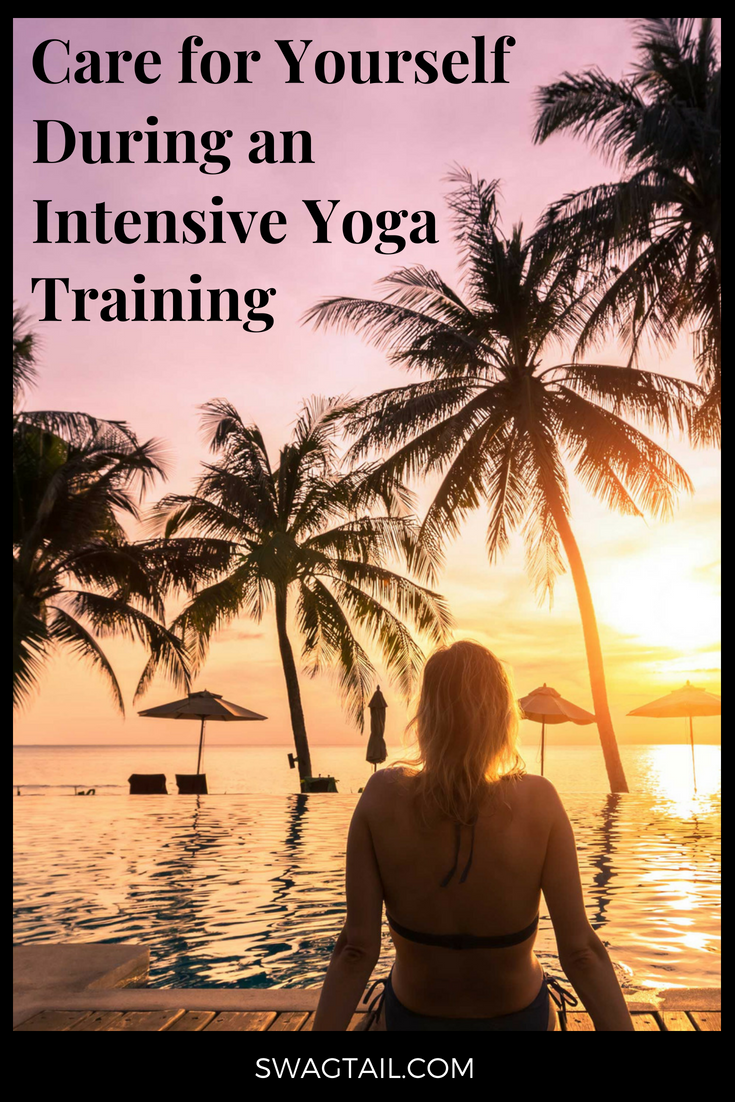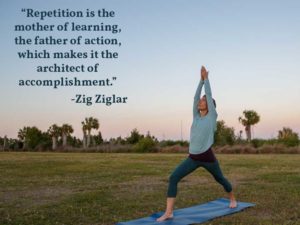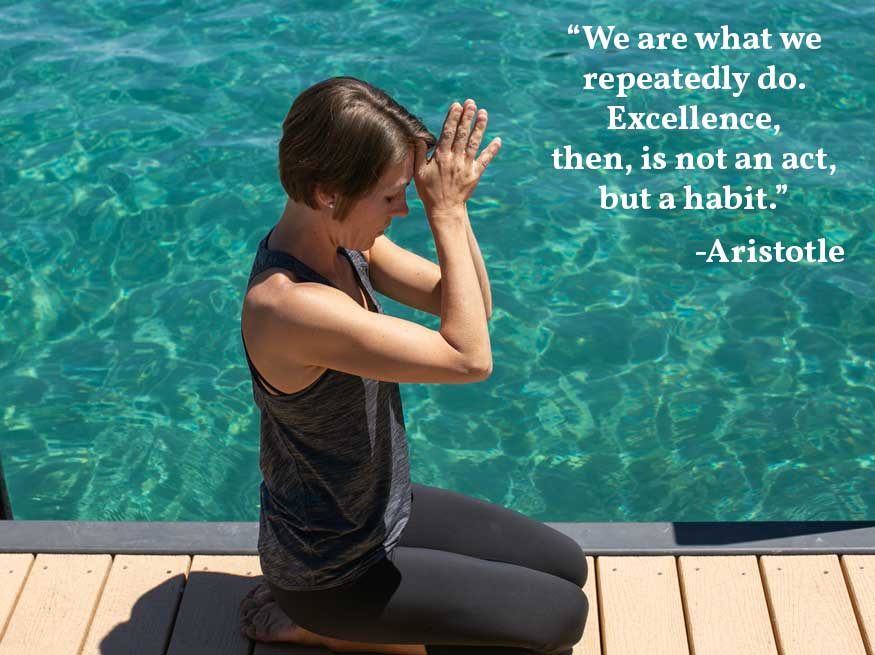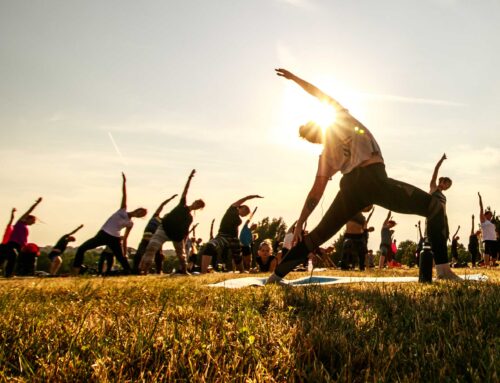 An intensive yoga training forms the foundation for becoming a yoga teacher. While various formats of a 200-hour training are available today, an intensive program allows you to solely focus on yoga, bond quickly with like-minded people, and put your new knowledge into practice via repetition. Yet, long days and lots of energy work–along with vast amounts of new information–can leave you feeling overwhelmed. To avoid this burnout and stay at the top of your game, we provide numerous tips to care for yourself along the way. This article shows you how.
An intensive yoga training forms the foundation for becoming a yoga teacher. While various formats of a 200-hour training are available today, an intensive program allows you to solely focus on yoga, bond quickly with like-minded people, and put your new knowledge into practice via repetition. Yet, long days and lots of energy work–along with vast amounts of new information–can leave you feeling overwhelmed. To avoid this burnout and stay at the top of your game, we provide numerous tips to care for yourself along the way. This article shows you how.
For several years, I coordinated and taught workshops nationwide. This required hours of planning, as well as clear communication to ensure all components were in place before the rest of the teaching team arrived. Then, when the events actually took place, I was up early to ensure registration went smoothly, products were in place, and all other logistics were well-organized. Many evenings were also spent arranging private sessions, dinners, and accommodation changes.
While I absolutely loved getting to meet new people and enjoy new cities throughout the country, I often found myself exhausted. It didn’t take long for me to realize that I needed to set aside time to care for myself along the way. This led to some mornings taking a local yoga class at a nearby venue, or even planning an entire day after the event to just clear my head.
This level of self-care has translated into my daily and weekly habits. It’s a way in which I demonstrate respect and love for myself. For when I listen to my own needs, and meet them first, I find an abundance of energy to serve those around me. The techniques suggested below are ones that were incredibly useful not only when I was an event coordinator, but when taking my own intensive yoga trainings. They’re also great tips to pass on to students who will be taking your own intensives in the months and years to come.
Photo Credit: NicoElNino
PROS OF AN INTENSIVE YOGA PROGRAM
When you have made the decision to carve consecutive weeks out of your schedule to participate in an intensive yoga training, you’re ready to make the most out of it. When you carry your passion for yoga and curiosity for learning into the process, you’re bound to thrive. You can also focus on these beneficial elements of this shortened training period to amplify a positive experience.
You get to geek out on yoga
For multiple hours on end, you’ll be surrounded by others who also share your enthusiasm for yoga. Soak it up. Geek out on it. Ask lots of questions, not only of your teacher, but of your fellow students. Each person in your group has a unique perspective on life, and differing experiences with their own body and yoga. Talk about styles, teachers, adjusting experiences, questions burning in your mind, and anything else yoga-related. Intensives are rare environments in which you can intentionally leave so much else behind and dive in to the training completely.
Information gets integrated quickly
Day in and day out you will be moving, studying, and exploring the various aspects of the yoga practice. Items that were covered one day will often be reviewed in the next few. You’ll get to ask questions while they are fresh in your mind. In addition, you’ll get to apply your newly-acquired knowledge into a practical way almost immediately.
For example, let’s say Monday’s lesson is about anatomy of the legs and feet and how those elements translate into yoga postures such as tadasana (or mountain pose). Then, within 24 hours, you could be verbally cueing a partner or small group to explore that very same asana. This blend of visual, auditory, and kinesthetic learning about a subject in a short period of time can increase the retention of new information.

Photo Credit: Casey Brooke Photography
There is lots of repetition
Repetition is essential to transitioning any knowledge from the brief holding container of the conscious mind to the memorized patterns of the subconscious. Think back to when you learned to ride a bike or drive a car. You were probably excited about the new experiences and wanted to do it as much as you could. Repetition of such activities increased both your confidence and skill set.
Practicing the skill of teaching yoga is no different. You’ll have lots of opportunities to instruct others on how to get into yoga poses. There will be countless moments to practice hands-on-assists or leading others through some breathing techniques. Just grab a newfound friend in your program–one who is just as eager to learn as you–and take advantage of the time to repeat what you are learning out loud.
You’ll bond deeply with great people
Working closely with others in the yoga environment can further boost your physical and psychological well-being. In 1995, two psychologists named Baumeister and Leary set out to find empirical proof that feelings of belonging increased motivation. The evidence they found was astounding, and their 26-page paper cites more than 300 sources all with the same results: belongingness leads to greater health and satisfaction. Ride the high energy of the group and enjoy the trust you build with those around you.
Challenges will be short-lived
Some components of the training will be easy to absorb, and other subjects might seem challenging. Because so much information is being covered each day, you will likely identify a subject you enjoy more than others within a short period of time. Even hurdles such as tests and homework assignments don’t last long in an intensive training. Just remember that your teachers want you to succeed. They will work with you and help you overcome difficulties that would hinder your progress.
You can be certified in a short period of time
This is perhaps the most highlighted perk of participating in an intensive training. For those who already work full time, you can combine vacation weeks to complete a course. Or, school teachers can do so on their summer or winter holiday. No matter your profession or path, this fast-track approach can certify you in a matter of weeks or months.

Photo Credit: Simon Migaj
CARE FOR YOURSELF IN THE PROCESS
Each yoga teacher training intensive is structured slightly differently. When they are organized in a way that builds trust with their students and creates an inclusive environment, your learning can thrive. Yet, no matter how organized a program will be, there can still be stress and strain during the experience. To minimize this, we suggest you care for yourself along the way.
Get a massage
This is a worthwhile and luxurious investment to consider during your intensive yoga training. You’ll be taking lots of yoga classes as well as spending many hours in a seated position to learn new material. Then there will be the intermittent poses and pseudo-practices throughout each day to help you understand postural assessments and teaching practices. This level of physicality is something quite abnormal to your normal routine, thus causing excess tension. Take care of yourself with a relaxing massage–once a week, if you can–to restore balance in your body tissue.
Schedule at least one night a week by yourself
When you get to spend three to four weeks with one group of people, you tend to form some great bonds with those individuals. You’ll be invited to share lunchtime. You’ll offer for someone else to join you for dinner. And, many times, a larger group will coordinate to explore fun events in the local area. While this outside-of-class bonding can be some of the most beneficial (and fun) times, see if you can stick to carving a little bit of time out for yourself. Do whatever it takes to bring you balance and joy in the moment. Meditate. Read an enjoyable, relaxing book. Or, even listen to uplifting music.
We do suggest some of this time alone be spent without your phone too. It can be all too easy to give your “alone” time to loved ones who are not with you in person. But just like spending time with others at dinner, cell phone time diverts your attention from the layers of transformation occurring within your being. Taking time alone, and consciously so, can allow those changes to rise to the surface for greater understanding.
This also prevents “groupthink” that can start to form with any combination of people. Taking time away will help you clarify which thoughts and emotions are yours, and yours alone.
Journal daily
We often suggest that you bring two notebooks to your training program. One can be used for various notes directly related to the content you are learning in class. The other can be used to reflect on your own personal growth in the journey. When you put your thoughts on paper, you can observe new insights and emotions with more clarity.
Stay fueled
Because many intensive yoga trainings are physically demanding, make sure to keep your body nourished throughout the day. During a recent training, we often joked that we were on the “squirrel diet,” as a light handful of nuts and dried fruit we ate each day provided us with the energy needed to focus. These snacks were light enough to allow us to strike poses at any given moment. You could even opt for smoothies, juices, or fresh fruit. Your body will tell you how to best keep it fueled and your needs might change from day to day. Just keep listening to your inner guide! It will steer you in the right direction.

Photo Credit: Brooke Lark
Savor satisfying thoughts
Yoga heightens your awareness of your body as well as that of your thoughts. You can use this new vantage point to observe how you respond to the intensive training experience. You might notice reflective thoughts based on the new information presented in class. You’ll also discover fresh ideas popping into your mind. And you will likely face a wide range of emotions that accompany those thoughts.
Instead of trying to make sense of everything at once, simplify your experience by asking yourself a simple question: “Is this thought satisfying?”
When you notice a good thought, savor it. Explore the thought further. Write about it in your journal. Enjoy the positive emotions that go with it. Then, if a thought is not satisfying in the moment, move on. Focus on what’s next. This will prevent you from wasting your energy and keep you present on what’s really important.
PREPARE FOR THE AFTERMATH
The end of an intensive training really signifies the beginning of a teaching path. While you might be ready to get right into the new phase of your life, or back to a more normal routine, consider taking some additional steps to help you transition back more smoothly.
Free up your schedule
Because of all the energy work and physical shifts that occurred during your training, you can be a very different person about to approach familiar habits, relationships, and schedule. In the rush to get back to what is familiar, you can lose the impact of such positive inner changes. Thus, we suggest you take a day or two to do nothing immediately after the training ends. Rest. Take walks in nature. Do something fun for yourself. Essentially, this lack of planning or structure can allow you to bring your new self and insights more fully into the next phase of your life–whatever that may be.
Photo Credit: Diane Nicole Photography
Pencil in some downtime
One of our favorite sayings is that when you buy a book, you’re also buying the time to read it. Well, you’ve already paid for (and completed) the training–which is similar to the book in the above analogy. Now it’s essential you carve out the time to really integrate your knowledge. The best way to do this is block off time for this in your planner in the weeks after the training. Maybe it’s one day a week for a few hours, or it could be 30-minutes every day.
Then, use this time to organize your notes. Reflect on your learning. Do more research in areas where you want to learn more about yoga and teaching. When you have the time already set aside, you’re far more likely to keep your positive momentum moving forward.
Stay on your mat
An intensive training has set times for practice already built into their program. But, it’s common to simply squeeze in yoga classes where they most easily (and sporadically) fit into our already-busy schedules. To ensure that you stay on your mat when you get home, book classes ahead of time. You might venture out and take new styles in your community. Or, you could commit to taking 3 or 4 classes a week with your favorite yoga teacher. You might even line up daily classes in your online cue. This ongoing physical practice is another powerful way you integrate your newly acquired knowledge.
PUTTING IT TOGETHER
Regardless of the format in which you complete your teacher training, the end of the program signifies the beginning of your teaching journey. In an intensive yoga format, you are immersed in yoga content. And you are able to build a strong bond with a group of individuals as well as better assimilate your new knowledge through repetition. When you take time to care for yourself along the way, you’ll be more satisfied and energized on the journey. Plus, you can have more clarity as you move forward in your everyday world.
Join us next week as we cover the agreements you make as a yoga teacher.









Leave A Comment